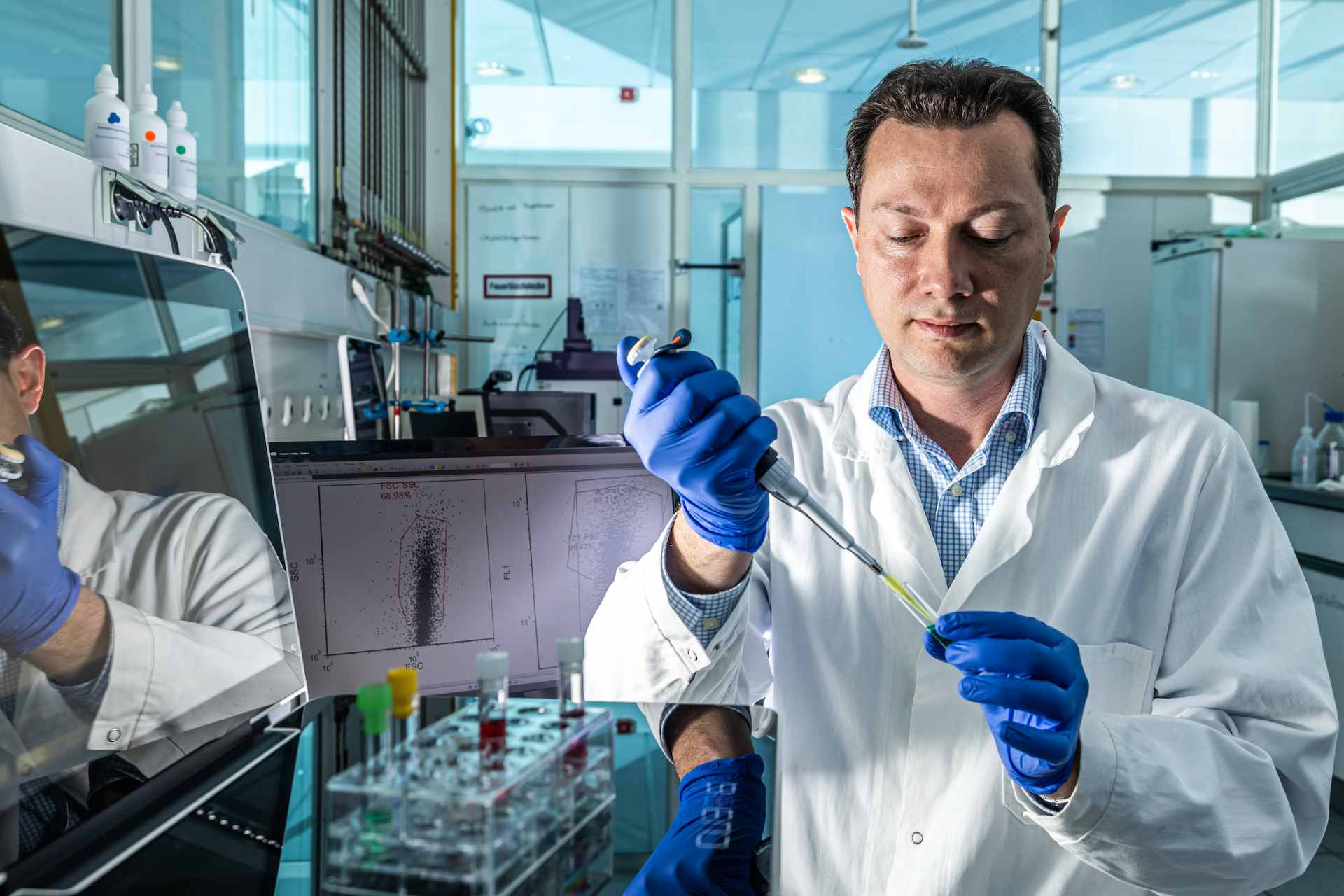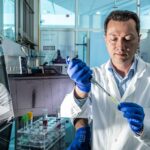Probiotic products are playing an increasingly important role in the modern health and nutrition industry. The quality and viability of the microorganisms they contain are crucial to their effectiveness. However, the precise and reliable determination of living probiotic cells has long posed a challenge. In July 2024, the journal Frontiers in Microbiology (1) presented a groundbreaking method that overcomes this hurdle: the Flow-FISH method.
Flow-FISH combines two proven technologies – fluorescence in situ hybridization (FISH), which has been used in academic research for decades, and flow cytometry. This combination enables the specific and highly precise analysis of living microorganisms directly in complex probiotic samples. It thus represents a milestone in the quality control of probiotic bacteria.
The significance of this innovation goes far beyond research. With the further development of the technology into user-friendly test kits, Flow-FISH has the potential to fundamentally improve quality control.
The technology behind Flow-FISH
The Flow-FISH method is based on the combination of two powerful methods: fluorescence in situ hybridization (FISH) and flow cytometry. This integration enables a precise and specific count of living bacteria in a sample, which was previously not achievable with this accuracy using conventional methods.
How does Flow-FISH work?
The central component of the method are specific gene probes that attach to unique sections of the ribosomal RNA (rRNA) of the bacteria. These RNA molecules are present in high concentrations in living cells as they are necessary for protein synthesis. Dead or inactive cells have significantly less rRNA, which makes them “invisible” for this method. The specificity of the gene probes is based on the phylogeny of the microorganisms and thus enables the targeted identification of bacterial genera, species or even subspecies.
After binding the gene probes to the target sequences, the labeled cells are analyzed using flow cytometry. The cells pass individually through a laser beam that detects the fluorescent signals. This signal is not only an indicator of the presence of the target organisms, but also a measure of their viability.
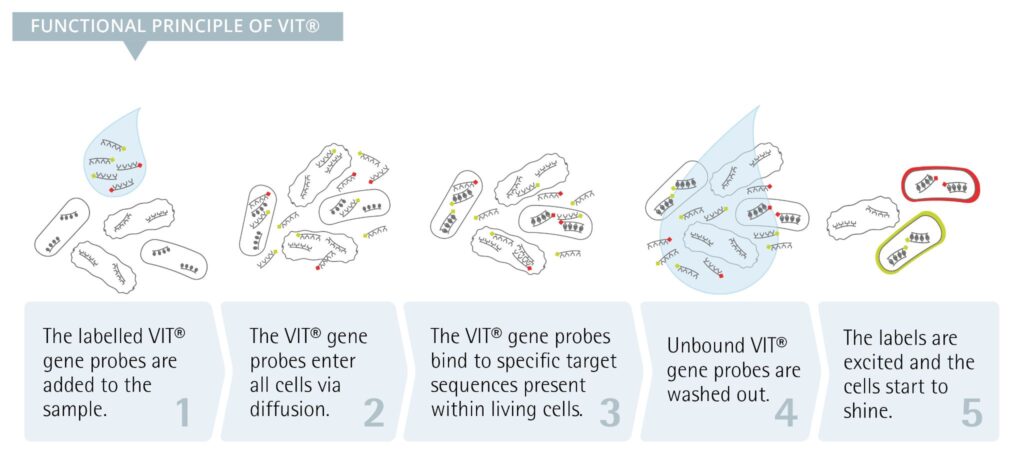
Why is this method revolutionary?
Flow-FISH offers several advantages compared to traditional techniques:
- Live counting: Only living cells are detected, providing a realistic picture of the microbial composition.
- Specificity: The method enables precise identification of individual microorganisms, even in complex samples with mixed populations.
- Speed: In contrast to cultivation-based approaches, Flow-FISH delivers results within 3-4 hours without the need for several days of cultivation.
From theory to application
After the initial development of the Flow-FISH method, the focus was initially on its use as a service. Companies from the probiotic industry can send in samples to be analyzed in the laboratory.
The next challenge was to adapt the method so that it could be used as a test kit directly in the user’s laboratory. The specificity and robustness of the technology as well as user-friendly handling had to be guaranteed.
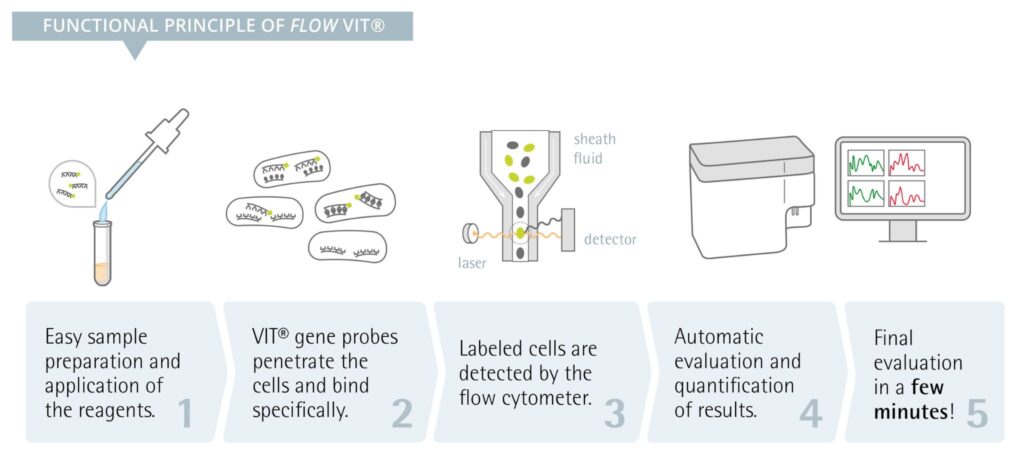
The Flow VIT® test kits: A new era of quality control
The Flow-FISH test kits (branding: Flow VIT®) represent a significant advance as they translate complex technology into an easy-to-use solution for routine laboratories.
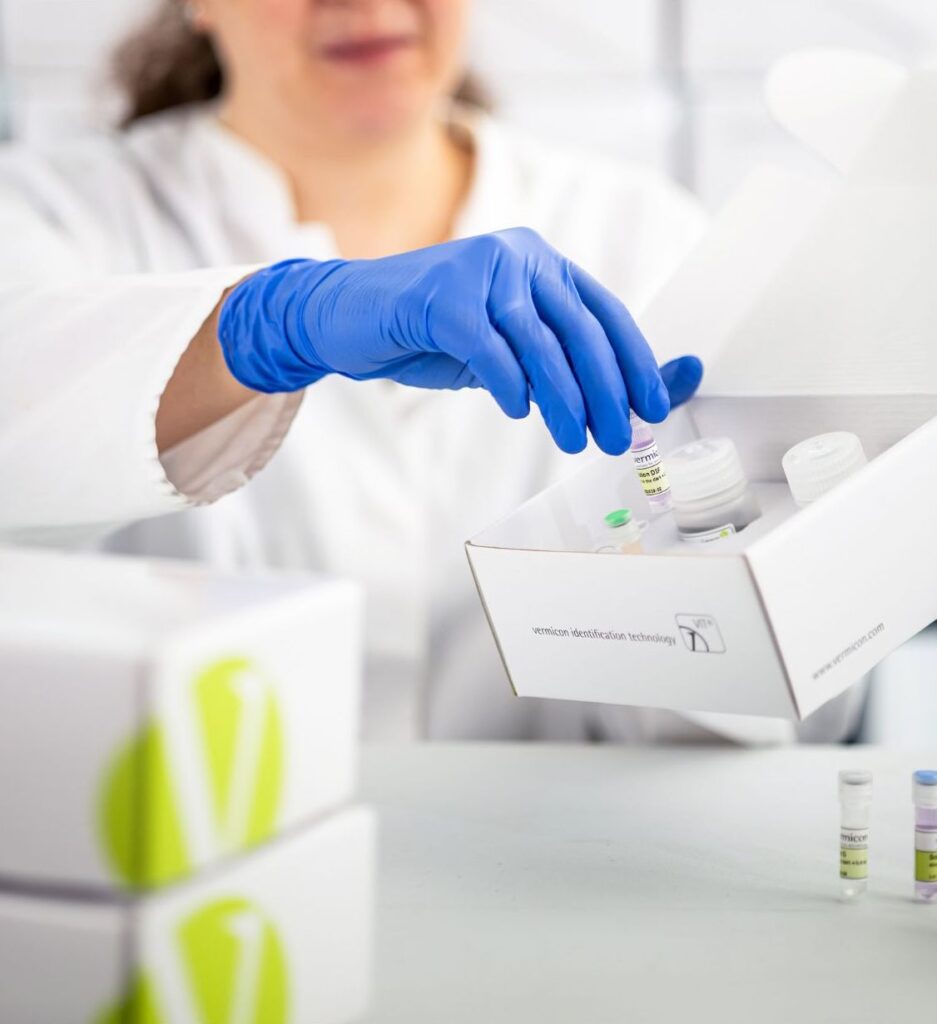
Development goals of the test kits
The development of the test kits was based on three central requirements:
- User-friendliness: The kits should be easy to use and can be used in everyday laboratory work without any special prior knowledge.
- Robustness: Despite its simplified handling, the high specificity and precision of Flow-FISH technology had to be maintained.
- Speed: The results should be available in a short time in order to increase the efficiency of quality control.
Technical requirements and flexibility
The Flow-FISH test kits are designed to be compatible with commercially available flow cytometers. This makes the technology accessible to a wide range of laboratories. At the same time, the modularity of the kits makes it possible to perform analyses for different probiotic bacteria and combine them as required.
Properties of the Flow VIT® test kits
The Flow VIT® test kits are characterized by a variety of features that make them an indispensable tool for the quality control of probiotic bacteria.
1. Specificity and precision
The test kits enable the precise identification and quantification of probiotic bacteria both in pure samples (e.g. lyophilizates) and in complex products such as mixed preparations (blends).
- Analysis of mixed populations: In products with several probiotic bacteria, the individual populations can be reliably differentiated.
- Accuracy: The specific gene probes of the Flow-FISH method ensure extremely precise detection of target bacteria, which significantly improves the analysis.
2. Reliable counting of living cells
In contrast to other methods, the Flow-FISH test kits only detect living cells. This is based on the high concentration of ribosomal RNA in active cells, which serves as a marker for viability.
- Exclusive counting of living cells: Unlike other methods where dead or damaged cells can lead to erroneous results, Flow-FISH provides a true-to-life picture of the actual viability of the bacteria.
- VBNC stage: The method also enables the detection of bacteria in the “viable-but-non-culturable” stage, which are often not detected by traditional cultivation methods.
3. Time saving and efficiency
The kits eliminate the need for lengthy cultivations as results are obtained directly from the sample.
- Fast results: While culture-based methods often take days, Flow-FISH delivers results within3-4 hours.
- Automated workflow: The kits are specially designed for routine applications and minimize manual effort.
4. Flexibility
The test kits have a modular design, which allows them to be adapted to different requirements.
- Variety of analysis options: Specific kits are available for different probiotic bacteria, which can be combined with each other to analyze the entire composition of a product.
- Compatibility: The kits are compatible with standard flow cytometers, which facilitates their use in existing laboratory facilities.
Comparison with traditional methods for live bacterial counts
Flow-FISH technology differs fundamentally from conventional methods for determining the viability of probiotic bacteria. While traditional methods such as cultivation, membrane integrity assays or respiratory chain assays often have limitations, Flow-FISH offers a more precise and realistic analysis.
1. Cultivation method
Cultivation on culture media is the most commonly used method for determining living bacteria. However, it has significant disadvantages:
- Non-culturable organisms: Many probiotic bacteria are difficult or impossible to cultivate on artificial media. Anaerobic microorganisms in particular pose a challenge.
- VBNC state: Bacteria in the viable-but-non-culturable (VBNC) stage are often not detected during cultivation, although they can become active again in the intestine.
- Colony formation: Several cells can join together to form a colony, which underestimates the actual cell number and thus falsifies it (CFU = Colony Forming Units). This leads to large deviations between different laboratories.
- Different growth conditions: Each bacterium has specific nutrient requirements that cannot be optimally met with a universal culture medium. This in turn leads to poor results.
- Stress factors: Bacteria often experience stress during production. These cells cannot grow on the plate, although they would still be functional in the intestine.
Conclusion: The cultivation method often provides inaccurate or underestimated results, as it does not capture all viable cells of a probiotic product.
2. Membrane integrity assays
Some methods assess viability based on the integrity of the cell membrane. This involves the use of DNA-intercalating dyes that have different abilities to penetrate intact membranes. An intact membrane is interpreted as an indicator of living cells.
- Advantage: The method is quick and comparatively easy to carry out.
- Disadvantage: It can also overlook damaged but still viable cells or interpret intact but dead cells as living. No specific detection.
3. Respiratory chain tests
This method measures the activity of the respiratory chain, e.g. by detecting cytochrome C.
- Advantage: It allows an assessment of metabolic activity.
- Disadvantage: Not all probiotic bacteria have an active respiratory chain, especially many anaerobic microorganisms that obtain their energy strictly from fermentation and substrate phosphorylation. No specific detection.
4. Flow-FISH in comparison
Flow-FISH technology overcomes the weaknesses of these methods and delivers significantly more accurate results:
- Specific analysis: By using phylogenetic gene probes, target organisms can be precisely identified even in complex mixtures.
- Detection of living cells: Only cells with active protein biosynthesis (high rRNA concentration) are detected, providing an accurate picture of viability.
- Speed: Results are available within 3-4 hours, in contrast to several days for cultivations.
- Realistic results: Flow-FISH maps the actual viability and composition of microorganisms, regardless of growth conditions or stress factors.
Traditional methods sometimes have considerable weaknesses. Flow-FISH combines precision, speed and realism.
Advantages of Flow VIT® test kits for different target groups
The Flow-FISH test kits offer a wide range of benefits tailored to the needs of different target groups in the probiotic industry and beyond. From manufacturers to regulatory authorities and researchers, all stakeholders benefit from the precision and efficiency of this innovative technology.
1. Probiotics manufacturers
For producers of probiotic products, reliable quality control is essential to ensure the efficacy and consistency of their products. The Flow-FISH test kits enable:
- Improved efficiency: The quick and easy application of the kits speeds up quality control and saves time in the production process.
- Reliability: The precise determination of living cells and specific probiotic bacteria species in mixtures guarantees a realistic assessment of product quality.
- Optimization of blends: With Flow-FISH, manufacturers can precisely determine the ratio of different types of bacteria in mixed products (blends) and ensure that the declared composition is adhered to.
2. Regulatory authorities
Compliance with quality and safety standards is an essential part of the probiotic industry. Flow-FISH offers:
- Reliable standards: The precise results of the test kits support the introduction of uniform standards for quality testing of probiotic products.
- Proof of minimum requirements: The specific counting of live bacteria makes it possible to ensure that products meet the required minimum numbers of live cells – both overall and for individual bacterial species.
- Objective evaluation: The method reduces the risk of deviations and misinterpretations that often occur with traditional methods.
3. Research and development
For scientists and developers, Flow-FISH offers a powerful tool for optimizing probiotic formulations:
- Facilitated formulation testing: The kits enable rapid and precise analysis of prototypes, which speeds up the development of new products.
- Checking the storage conditions: Flow-FISH can be used to analyze the stability and viability of probiotics under different storage conditions.
- Basic research: The detailed analysis of the microbial composition allows new insights into the interaction of bacterial strains to be gained without the sources of error of conventional methods.
4. Laboratories and quality inspectors
Laboratories that carry out routine analyses benefit from:
- Simplicity of use: The automated workflow reduces manual effort and minimizes sources of error.
- Flexibility: The modular kits can be adapted to specific requirements and combined with each other.
- Time saving: Compared to cultivation-based methods, the test kits deliver results within a few hours.
The Flow-FISH test kits are a versatile toolbox that greatly simplify quality control and research in the probiotic industry. Each target group benefits in its own way – from ensuring regulatory compliance to developing new products and optimizing existing processes.
Which Flow VIT® test kits are available?
Several commercial Flow VIT® test kits are currently available.
1. Flow VIT® Bifidobacterium
This kit is designed for the entire genus of Bifidobacteria. It is ideal for determining the total amount of these health-promoting microorganisms in products.
2. Flow VIT® Bifidobacterium lactis
A specific kit for the detection of the species Bifidobacterium lactis, which is often used in probiotic preparations due to its positive effects on intestinal health.
3. Flow VIT® Bifidobacterium longum
This kit was developed to detect the species Bifidobacterium longum. This bacterial species plays an important role in supporting the immune system and digestion.
4. Flow VIT® Bifidobacterium breve
This kit can be used to precisely identify the species Bifidobacterium breve, which is mainly used to promote the health of infants and young children.
5. Flow VIT® Lactobacillus rhamnosus
A specific kit for Lactobacillus rhamnosus, one of the most widely used probiotic strains with multiple health benefits, including immune system support.
6. Flow VIT® Lactobacillus plantarum
This kit is intended for the analysis of Lactobacillus plantarum, a bacterium known for its antioxidant properties and its role in fermentation.
7. Flow VIT® Lactobacillus acidophilus
This kit identifies Lactobacillus acidophilus, a probiotic strain commonly found in dairy products and dietary supplements.
Advantages of the kit selection
- Diversity: The different kits enable precise analysis of both individual bacterial species and entire genera.
- Combinability: Multiple kits can be combined as needed to comprehensively analyze mixtures of probiotics in a product.
- Flexibility: Each kit is designed to be compatible with common flow cytometers, allowing easy integration into existing laboratory workflows.
The current range of Flow VIT® test kits provides users with a powerful tool to reliably test the quality and composition of probiotic products. These kits already cover a wide range of the most important probiotic bacteria and ensure that both pure preparations and complex mixtures can be analyzed efficiently.
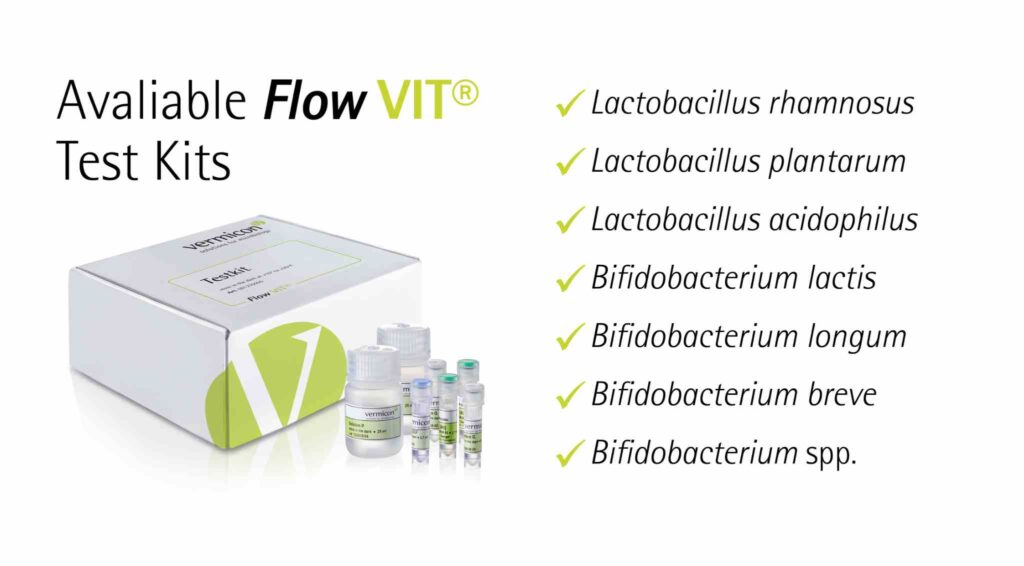
Outlook
The Flow-FISH test kits already mark a milestone in the quality control of probiotic bacteria. But the development does not end here. Through continuous research and innovation, the technology will make further progress in the coming years and create new application possibilities.
1. Expansion of the kit portfolio
The demand for precise analysis methods is growing, especially as the variety of probiotic products on the market is constantly increasing. The development of further test kits covering additional probiotic bacteria is planned.
2. Availability
Flow VIT® test kits are already marketed worldwide. The addition of further international partners will shorten delivery routes and further optimize on-site supply.
3. Training courses
To date, live remote training and training courses have been offered at vermicon AG’s development site at Munich Airport. A video training seminar will be launched in 2025
A new standard in quality control
Flow-FISH technology has the potential to establish itself as the global standard for the analysis of probiotic bacteria. With precise, fast and flexible testing options, it offers not only the probiotic industry, but also research and regulatory authorities tools that are qualitatively far superior to previous methods.
Through continuous further development, Flow-FISH will not only optimize quality control, but also promote new scientific findings and have a lasting influence on product development in the probiotic industry.
Author: Dr. Jiri Snaidr and Laura Snaidr, vermicon AG, Germany

